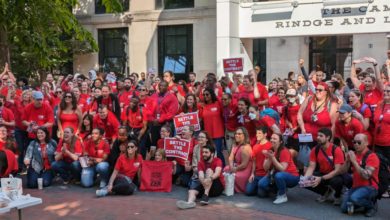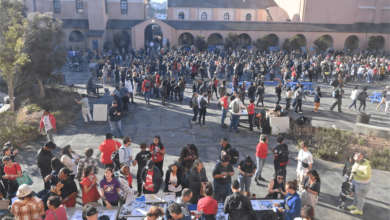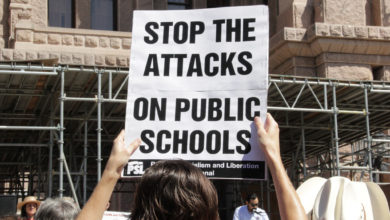Photo: Downtown Boise, Idaho. Source: Patrick Rodriguez, CC by SA
Idaho began the 20-21 school year without a statewide plan for reopening schools, leaving families and teachers facing uncertainty as classes begin.
The anxiety teachers are experiencing as they begin the fall semester during pandemic is beyond the routine anxiety of a new school year. Many wrote their wills before beginning the school year, as per the National Education Association’s recommendation. Governor Brad Little and the right-wing legislature in Idaho voted to decrease education spending by 5 percent for the coming academic year. Idaho for many years has ranked 49th in education spending. Teachers are being asked to do more – this time facing serious illness or death – with less.
Meanwhile, there is no state moratorium on evictions or cancellation of rents and mortgages, leaving many families on the edge of ruin with no guarantees for their housing or their children’s education. Access to a computer and Internet are essential to online education, yet 17 percent of Idaho households lack Internet access. (NCES 2017) While school districts scramble to distribute Chromebooks and iPads and create Wi-Fi hotspots, those facing homelessness or without proper Wi-Fi currently will not be equipped to attend class or submit homework. In regards to schools reopening, the state refused to take action, leaving the decision to individual school boards.
Teachers and parents came away from area school board meetings in mid August even less assured, much less with a cohesive plan. However, Nampa School District was an exception, voting to go fully online for the fall semester. Boise School District decided to start the first three weeks online, then reconsider reopening for in-person instruction if the COVID-19 infection rate is below 5 percent. Only this past week has the infection rate dropped below 10 percent for the first time in months. West Ada School District, the state’s largest district, delayed starting until Sept. 8, but in a recent meeting announced they would do one week online.
Multiple educational associations and health departments have strongly recommended that schools remain closed to in-person meetings. But across both counties schools have unrolled plans to reopen.
Speaking on condition of anonymity, one West Ada teacher shared the following frustrations: “Many of us are very frustrated. We had to fight to get them to close in March, then again in April.” She described the school’s callous disregard for public health when they scheduled a pool party for 40,000 students and staff.”They clearly weren’t taking the virus seriously and thankfully we got parents to back us, so they cancelled that. They begrudgingly sent out a notice saying they cancelled due to feedback but said they were still following guidelines.” The teacher went on to comment that frustration levels have reached the point that “around 80 percent would go on strike, if we are asked to go back when it’s unsafe.”
Another shocking development was the creation of the “Virtual Schoolhouse” in the West Ada district over the summer. This “school” would only serve online students, and essentially be a separate school with students withdrawing from their current school to enroll in the virtual school. This was the only option offered to immunocompromised teachers to allow them to continue teaching. Teachers choosing the Virtual Schoolhouse would have their original contract nullified. The West Ada teacher noted, “the rest of us have no other option, but to do what the district asks or resign.”
In contrast, Nampa School District consulted public health experts, teachers and parents before deciding to open online. Nampa teacher Bekah Graves explained, “While I felt very disappointed that we are starting online, I just didn’t see that there was any other choice… we also felt a lot of relief that we weren’t being pushed into a potentially unsafe and unknown environment.” Unfortunately for other districts, teachers have not felt that same sense of relief as schools open.
At the College of Western Idaho (CWI), Idaho’s largest community college with 33,000 enrolled students, the focus has been on reopening campus for fall classes. With a student body, faculty and staff composed of working class people, they all depend on public schools being open in order to either attend classes or work. An update following local school board decisions was promised from the administration but never came. Instead, an article in the local newspaper appeared announcing the college’s plans to reopen. The college’s spokesperson falsely declared that class capacity had been reduced by 50 percent, when in reality the limit on students enrolled in a course had been reduced from 29 to 24 students.
Many of the classrooms are too small to allow for proper social distancing even with caps at 24. With surrounding schools announcing varying plans for reopening, the college did not change course. This puts students, teachers and staff at CWI in the impossible position of having to deal with their children being at home online for school while reporting back to campus for in-person classes.
Teachers across the country confront similar grim choices exposing the lack of any unified plan that prioritizes the health and life of students, teachers and their families. For decades teachers have been the punching bag of bipartisan efforts to defund and privatize education by demonizing the very people charged with educating our children. The pandemic and the complete lack of leadership on both sides of the capitalist bourgeoisie political parties makes clear the brutal contradictions of a ruling class more concerned with generating profits than protecting lives. Schools and teachers are essential not only for education but for childcare and feeding children who would otherwise not eat, among many other aspects necessary for the country and economy to function. It is not just teachers and students whose lives are put on the line as schools start, but families as well who have been provided no other options but to work or face eviction and exposing themselves to infection.
It is essential to remember that we, as the working class, are in this together. Our lives are literally on the line and we should not be faced with the choice of working or dying during an unprecedented pandemic. We cannot be reduced to begging for our lives, we must recognize our common interests and organize together to demand canceling the rents, a moratorium on mortgages, financial assistance to pay our bills throughout the pandemic and that our health and safety be the priority, not the economy. It is only when we unite together and fight for our lives that we can achieve the sorts of protections needed to not lose our homes or die returning to school.






